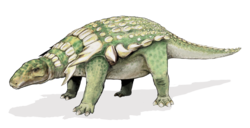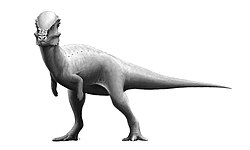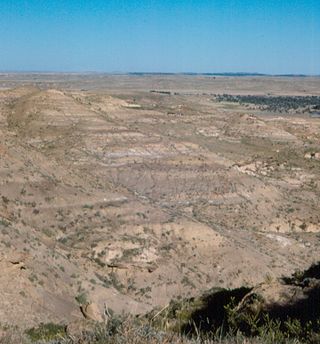Lance Formation
Geological formation in the United States From Wikipedia, the free encyclopedia
The Lance (Creek) Formation is a division of Late Cretaceous (dating to about 69–66 Ma) rocks in the western United States. Named after Lance Creek, Wyoming, the microvertebrate fossils and dinosaurs represent important components of the latest Mesozoic vertebrate faunas. The Lance Formation is Late Maastrichtian in age (Lancian land mammal age), and shares much fauna with the Hell Creek Formation of Montana and North Dakota, the Frenchman Formation of southwest Saskatchewan, and the lower part of the Scollard Formation of Alberta.
| Lance Formation | |
|---|---|
| Stratigraphic range: Maastrichtian ~ | |
 Badlands in the Lance Formation along Cow Creek near the type locality, Niobrara County, Wyoming | |
| Type | Sedimentary |
| Underlies | Fort Union Formation |
| Overlies | Meeteetse Formation |
| Thickness | up to 600 metres (1,970 ft) |
| Lithology | |
| Primary | Sandstone, siltstone, shale |
| Location | |
| Region | Wyoming |
| Country | United States |
| Type section | |
| Named for | Lance Creek, Wyoming |

The Lance Formation occurs above the Baculites clinolobatus ammonite marine zone in Wyoming, the top of which has been dated to about 69 million years ago, and extends to the K-Pg boundary, 66 million years ago. However, the characteristic land vertebrate fauna of the Lancian age (which take its name from this formation) is only found in the upper strata of the Lance, roughly corresponding to the thinner equivalent formations such as the Hell Creek Formation, the base of which has been estimated at 66.8 million years old.[1]
Description
The formation is described by W.G. Pierce as thick-bedded, buff-colored sandstone, and drab to green shale. It is Upper Cretaceous in age.[2]
The formation varies in thickness from about 90 m (300 ft.) in North Dakota, to almost 600 m (2,000 ft.) in parts of Wyoming.
Depositional environment
The Lance Formation was laid down by streams, on a coastal plain along the edge of the Western Interior Seaway. The climate was subtropical; there was no cold season and probably ample precipitation.
Paleontology
Summarize
Perspective
At least tens of thousands of Late Cretaceous vertebrate remains have been recovered from the Lance Formation. Fossils ranging from microscopic elements to extensive bonebeds, with nearly complete, sometimes articulated dinosaur skeletons, have been found.[3] Most other animals known from the formation are freshwater animals, and some are exclusively freshwater forms (for instance, frogs and salamanders). However, marine fossils are also found in the formation, suggesting that the sea was nearby. The bird fauna is mainly composed of orders still existing today.
Coelurosaurs
Color key
|
Notes Uncertain or tentative taxa are in small text; |
Birds
| Birds reported from the Lance Formation | ||||||
|---|---|---|---|---|---|---|
| Genus | Species | Location | Stratigraphic Position | Material | Notes | Images |
|
A. retusus |
Reclassified as Palintropus retusus |
|||||
|
C. major |
A possible charadriiform bird | |||||
|
C. petra |
Reclassified as Lamarqueavis minima[5] | |||||
|
C. rara |
|
A charadriiform | ||||
|
C. retusa |
Reclassified as Palintropus retusus | |||||
|
C. minima |
Reclassified as Lamarqueavis minima[5] | |||||
|
"Cimolopteryx" |
"C." maxima |
|
A charadriiform bird, not necessarily closely related to Cimolopteryx.[4] | |||
|
G. augustus |
|
A possible charadriiform[6] | ||||
|
L. minima |
|
A charadriiform[5] | ||||
|
L. petra |
|
A charadriiform[5] | ||||
|
L. estesi |
|
A possible procellariiform[6] | ||||
|
"Lonchodytes" |
"L." pterygius |
|
A possible charadriiform[6] | |||
|
"P." vetus |
A bird similar to gruids, idiornithids and presbyornithids.[6] | |||||
|
P. retusus |
|
A basal ornithuromorph belonging to Ambiortiformes.[7] | ||||
|
P. skutchi |
A hesperornithiform possibly also present in the Hell Creek Formation.[8] | |||||
|
T. clemensi |
|
A possible pelecaniform[6] | ||||
|
Unnamed presbyornithid |
Indeterminate |
|||||
|
Unnamed enantiornithean |
Unnamed |
|
An enantiornithean, previously referred to "Ornithomimus" minutus[11] | |||
|
Unnamed avian |
Indeterminate |
|
||||
|
Unnamed phalacrocoracid |
Indeterminate |
|
A possible phalacrocoracid[6] | |||
|
Unnamed galloanserine |
Indeterminate |
A possible galloanserine[12][13] | ||||
|
"Unnamed ornithurine A"[4] |
Indeterminate |
Originally thought to belong to Cimolopteryx rara, but probably a new species. Also present in the Frenchman Formation.[4] | ||||
|
"Unnamed ornithurine C"[4] |
Indeterminate |
|
Also present in the Hell Creek Formation.[4] | |||
|
"Unnamed ornithurine E"[4] |
Indeterminate |
Also present in the Hell Creek Formation.[4] | ||||
|
"Unnamed ornithurine F"[4] |
Indeterminate |
Originally thought to belong to "Cimolopteryx" maxima, but probably a new species.[4] | ||||
Other coelurosaurs
An isolated tooth crown of an indeterminate coelurosaur is recovered from the formation.[13]
| Miscellaneous coelurosaurs of the Lance Formation | ||||||
|---|---|---|---|---|---|---|
| Genus | Species | Location | Stratigraphic Position | Material | Notes | Images |
|
A. amplus |
Teeth, type specimen |
Dubious tyrannosaurids probably synonymous with Tyrannosaurus rex |
   | |||
|
A. cristatus |
Teeth, type specimen | |||||
|
"O." sedens |
"Sacrum and fragmentary illium"[14] type specimen |
An ornithomimid. | ||||
|
P. caperatus |
Teeth, type specimen |
A troodontid | ||||
|
P. bakkeri |
Teeth, type specimen |
|||||
|
T. rex |
Several partial specimens and teeth |
A tyrannosaurid originally identified from the Hell Creek Formation. Also found in the Denver, Ferris, Frenchman, Javelina, Livingston, McRae, North Horn, Scollard, and Willow Creek Formations. Synonyms with type specimens from this formation include Dynamosaurus imperiosus and Manospondylus gigas.[15] | ||||
| Nanotyrannus | N. lancensis | Synonym of Tyrannosaurus. | ||||
| Trierarchuncus[13] | cf. T. prairiensis |
|
An alvarezsaurid originally identified from the Hell Creek Formation. | |||
| Caenagnathidae[16][17] | Indeterminate | UCMP 143274 | Previously identified as a parrot[18] | |||
| Troodontinae[13] | Indeterminate | YPM VP 004691 | Not referrable to Paronychodon or Pectinodon. | |||
| cf. Microraptoria[13] | Indeterminate |
|
Potentially the youngest microraptorian specimens, but YPM VP 865 may belong to the Unenlagiinae or Halszkaraptorinae.[13] | |||
| Eudromaeosauria[13] | Indeterminate | YPM VPPU 20589 | ||||
Ornithischia
Ankylosaurs
| Ankylosaurs of the Lance Formation | ||||||
|---|---|---|---|---|---|---|
| Genus | Species | Location | Stratigraphic Position | Material | Notes | Images |
|
A. magniventris [19] |
|
More than 70 osteoderms and a tooth |
An ankylosaurid, originally identified from the Hell Creek Formation. |
   | ||
| Denversaurus | D. schlessmani | Wyoming | FPDM-V9673,[20][21] formerly BHI 127327[22] | A nodosaurid, originally identified from the Hell Creek Formation.[23] | ||
|
E. sp.[24] |
|
Teeth |
A nodosaurid. Fossils have been unearthed in the Hell Creek Formation, the Ferris Formation, the Dinosaur Park Formation, the Horseshoe Canyon Formation, and the Denver Formation.[25][26][27][28][29] | |||
|
"P. latus"[24] |
|
Teeth |
Probably a nodosaurid, but the teeth could also belong to the Pachycephalosauridae.[30] | |||
Marginocephalians
| Marginocephalians reported from the Lance Formation | ||||||
|---|---|---|---|---|---|---|
| Genus | Species | Location | Stratigraphic Position | Material | Notes | Images |
|
A. sylvestris |
"Partial sacrum and pelvis,"[31] type specimen. |
A dubious ceratopsid probably synonymous with Triceratops horridus |
      | |||
|
L. gracilis[32] |
A ceratopsian | |||||
|
N. hatcheri |
"[One] skull,"[31] type specimen. |
A ceratopsid possibly synonymous with Triceratops horridus.[33] Synonyms include Diceratops hatcheri and Diceratus hatcheri. | ||||
|
P. wyomingensis |
Fragmentary specimens including the type specimen. |
A pachycephalosaur. Synonyms with type specimens from this formation include Troodon wyomingensis. | ||||
|
"Palaeoscincus" |
"P." latus |
"Tooth."[30] |
A dubious pachycephalosaur, previously classified as the ankylosaur Palaeoscincus | |||
|
S. spinifer |
A pachycephalosaur possibly synonymous with Pachycephalosaurus wyomingensis[34] | |||||
|
T. latus |
Several specimens including the type specimen. |
A ceratopsid possibly synonymous with Triceratops horridus.[33] Torosaurus gladius, with type specimen from this formation, is a synonym. Also present in the Frenchman and Hell Creek Formations. | ||||
|
T. horridus |
"Partial skull and skeleton,"[31] type specimen |
A ceratopsid, also found in the Evanston, Frenchman, Hell Creek, Laramie, and Scollard Formations. Synonyms with type specimens from this formation include T. ingens and T. sulcatus.[31] | ||||
Ornithopods
Indeterminate lambeosaurinae fossils have been found in the Lance Formation.[35]
| Ornithopods of the Lance Formation | ||||||
|---|---|---|---|---|---|---|
| Genus | Species | Location | Stratigraphic Position | Abundance | Notes | Images |
|
E. annectens |
Skull, skeletons, including the type specimen, "mummy", and a bone bed.[36] |
A hadrosaurid. Synonyms from this formation include Anatosaurus annectens and Claosaurus annectens. Also found in the Frenchman, Hell Creek, Laramie and Scollard Formations. |
  | |||
|
T. neglectus |
Well-preserved skeleton, type specimen |
A thescelosaurid.[37] Also found in the Frenchman, Hell Creek, Laramie and Scollard Formations. | ||||
|
T. occidentalis |
Teeth, vertebrae, toe bone (including type specimen) |
A dubious hadrosaurid possibly synonymous with E. annectens | ||||
|
"T." longiceps |
One partial jaw (YPM 616), type specimen |
A dubious hadrosaurid possibly synonymous with E. annectens | ||||
Other vertebrates
Other land vertebrates include pterosaurs (e.g. cf. Quetzalcoatlus),[38] crocodiles, champsosaurs, lizards, snakes, turtles, frogs and salamanders.
Remains of fishes and mammals (i.e. Nanocuris) have also been found in the Lance Formation.
See also
- List of fossil sites (with link directory)
- List of dinosaur-bearing rock formations
References
External links
Wikiwand - on
Seamless Wikipedia browsing. On steroids.
